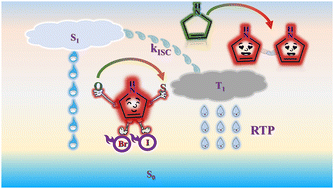Role of halogen effects and cyclic imide groups in constructing red and near-infrared room temperature phosphorescence molecules: theoretical perspective and molecular design†
Abstract
Organic room temperature phosphorescence (RTP) has been widely investigated to realize long-lifetime luminescent materials and improvement in their efficiency is a key focus of research, especially for red and near-infrared (NIR) RTP molecules. However, due to the lack of systematic studies on the relationship between basic molecular structures and luminescence properties, both the species and amounts of red and NIR RTP molecules remain far from meeting the requirements of practical applications. Herein, based on density functional theory (DFT) and time-dependent density functional theory (TD-DFT) calculations, the photophysical properties of seven red and NIR RTP molecules in tetrahydrofuran (THF) and in the solid phase were theoretically studied. The excited state dynamic processes were investigated by calculating the intersystem crossing and reverse intersystem crossing rates considering the surrounding environmental effects in THF and in the solid phase using a polarizable continuum model (PCM) and quantum mechanics and molecular mechanics (QM/MM) method, respectively. The basic geometric and electronic data were obtained, Huang–Rhys factors and reorganization energies were analyzed, and natural atomic orbital was used to calculate the orbital information of the excited states. Simultaneously, the electrostatic potential distribution on molecular surfaces was analyzed. Further, intermolecular interactions were visualized using the molecular planarity binding independent gradient model based on Hirshfeld partition (IGMH). The results showed that the unique molecular configuration has the potential to achieve red and NIR RTP emission. Not only did the substitutions of halogen and sulfur make the emission wavelength red-shifted, but also linking the two cyclic imide groups could further make the emission wavelength longer. Moreover, we found that the emission characteristics of molecules in THF had a similar trend as in the solid phase. Based on this point, two new RTP molecules with long emission wavelengths (645 nm and 816 nm) are theoretically proposed and their photophysical properties are fully analyzed. Our investigation provides a wise strategy to design efficient and long-emission RTP molecules with an unconventional luminescence group.

- This article is part of the themed collection: 2023 PCCP HOT Articles


 Please wait while we load your content...
Please wait while we load your content...